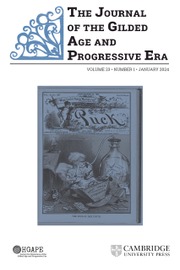This issue of The Journal of the Gilded Age and Progressive Era is, in many ways, about the imagination. Specifically, the articles examine how turn-of-the-century Americans perceived their place within a rapidly changing world and, in turn, projected their visions as a means to gain power or wealth, promote dubious economic policies, and advance moral causes.
In the first article, “Teddy’s Bear Country: Imagining Wild Nature in Theodore Roosevelt’s America,” Malcolm McLaughlin reminds us that few Americans encountered real bears in the early twentieth century. But as bears became symbolic of a wild world that appeared to be passing, sportsmen and journalists turned the creatures into a consumer commodity. The bearskin rug seemed to tame nature and make it suitable for the domestic realm. Meanwhile, Theodore Roosevelt’s association with hunting prompted Americans to picture a forward-looking nation that was nevertheless comfortably rooted in a strenuous past. Similarly, Benjamin Wise’s “Downfall Voyeurism: Jazz Dancing and the Making of Moral Concern in America” shows how conservative Americans in the 1910s (and beyond) strove to imagine – and to capitalize upon – the moral depravity they associated with jazz dancing. It was not enough for preachers and patriarchs to condemn new cultural forms. Rather, they had to provide readers and listeners with vicarious enjoyment, to make them feel the cultural danger. This was an incredibly modern way of reacting against modernity, and of claiming to preserve traditional morals.
Indeed, many Americans sought protection in times of great change. As James Patrick Breen argues in “A Menace to Free Labor: Anti-Catholicism, the American Protective Association, and Working-Class Formation in Gilded Age America,” the American Protective Association stirred the imagination of native-born, Protestant Americans who feared they might lose their jobs, or even their freedoms, because of Catholics supposedly beholden to Rome. Tales of slave labor and “papist” automatons were fanciful, but lack of substance did not prevent some labor leaders from using such narratives in a persistent, and xenophobic, quest to protect the nation from outside forces. Fritz Kusch, meanwhile, focuses our attention upon the debate regarding tariffs in “Picturing Protectionism: The Tariff Question in Protectionist Cartoon Propaganda in the United States, 1894–1909.” Pro-tariff groups used cartoons to inspire Americans to imagine the benefits of economic protectionism. In these visual images, anti-tariff politicians were dastardly saboteurs, while President William McKinley was an American hero. (Sometimes, truly, the present mimics the past in strange and unexpected ways.) In the Gilded Age imagination, tariffs were not just taxes. Rather, they were dikes that retained threatening floodwaters, or fences that protected livestock from poachers. Tariffs, such cartoons promised, filled the proverbial dinner pail. Who needed to understand the messy and complicated realities of economic policy when propagandists could simply produce images abundant with metaphors of industry and prosperity?
In “‘The Swindle of the Century’: Fraud, Finance, and Femininity in the Gilded Age,” Matt Smith unpacks the story of Thérèse Humbert, a French confidence woman who borrowed millions in the late 1800s and early 1900s against an imaginary American inheritance. Yet the opening of a safe in May 1902 showed that there was virtually nothing to back the loans, other than a tantalizing story. Extensive coverage of this story in U.S. newspapers illustrated then-prevalent attitudes toward women, finance, and the purported physical appearance of deviants. Humbert’s sensational case serves as an incisive lens on the era’s cultural assumptions regarding gender and money. Finally, the ten book reviews that close out this issue examine an array of topics ranging from Black bicyclists to the rise and fall of the Freedman’s Bank, the legacy of Nathan Bedford Forrest, the creation of the port of Los Angeles, manual training schools, and the impact of presidential leadership on the Gilded Age economy.
The contents of this issue shed light on fears that echo well into our own time. How can present-day Americans protect their economic well-being from seemingly overwhelming extranational forces? How might modern people insulate themselves from bewildering cultural or technological changes – while perhaps continuing to enjoy the thrills and opportunities that those changes seem to promise? And, ultimately, how do we protect our society, our body politic, from swindlers of all types? These questions are by no means new, and neither is the fact that it behooves us to interrogate the need for protection – and to discern who benefits if we focus our imagination on fears and ostensible threats. By seeking to understand the Gilded Age and Progressive Era imagination, certainly, we may learn something about our own troubled society.

